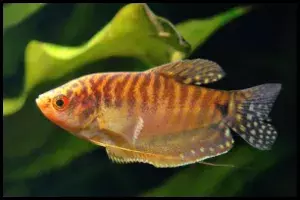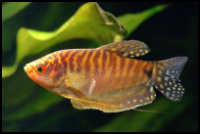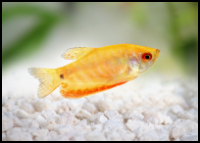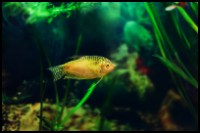




Quick Care Details (Table)
| Livestock Characteristics | Value |
|---|---|
| Care Level | Easy |
| Temperament | Semi-Agressive |
| Diet | Omnivore |
| Maximum Size | 6 Inches |
| Minimum Tank Size | 30 Gallons |
| Plant Safe | Yes |
| Temperature Range | 75-82°F |
| PH Range | 6.0-7.5 pH |
| KH Range | 4-10 dKH |
| GH Range | 5-15 dGH |
Species Specific Categories
Helpful Video
Care Details
Aquascape
- Vibrant golden coloration adds elegance to the aquascape
- Provide plenty of plants, driftwood, and rocks for hiding spots and swimming areas
- Create a well-designed aquascape with open spaces and vegetation
Substrate
- Adaptable to various substrates like sand or small-grain gravel
- Dark-colored substrate enhances coloration
- Ensure substrate is clean and free from sharp edges
Disease prevention
- Maintain a clean and well-maintained tank
- Regular water changes and proper filtration are essential
- Quarantine new fish before introducing them to prevent the spread of diseases
Filtration
- Use a reliable filter system (canister, hang-on-back) for optimal water quality
- Provide gentle but consistent water movement
- Moderate water flow is preferred by the Golden Gourami
Lighting
- Adequate lighting showcases vibrant coloration
- Mimic a natural day-night cycle with periods of darkness
- Include floating plants or shaded areas for security
Water Flow
- Moderate water flow is preferred
- Position filtration outlets to create a gentle current
- Avoid excessive water flow or stagnant water
Temperament and Behavior
Behavior
- Curious and active fish
- Can be territorial, especially during breeding times
- Known to establish territories within the tank
- Can display aggressive behavior towards conspecifics or similar-looking fish
Breeding
- Bubble nest builder
- Males construct nests at the water surface using bubbles and plant materials
- Females lay eggs that are fertilized by the males
- Remove adults after spawning to protect the eggs and fry
Compatibility
- Generally peaceful fish
- May show aggression towards similar-looking fish or those with long flowing fins
- Best kept with other peaceful community fish
- Avoid keeping with fin-nipping or aggressive species
Tankmates
- Peaceful community fish make suitable tankmates
- Avoid fin-nipping or aggressive species
- Good tankmates include tetras, rasboras, peaceful catfish, and livebearers
- Provide plenty of hiding spots and open swimming areas
Activity Level
- Active fish that enjoy exploring their surroundings
- Frequent swimmers, especially in the middle and upper areas of the tank
- Can display bursts of speed and playful behavior
Clean up Crew
- Not known for actively scavenging or cleaning the tank
- May eat some leftover food or small invertebrates
- Consider adding a separate clean-up crew, such as snails or shrimp, for efficient tank cleaning
Diet and Nutrition
Dry Foods
- Golden Gouramis readily accept dry foods such as pellets and flakes.
- Look for high-quality commercially prepared fish foods specifically formulated for tropical fish or gouramis.
- Ensure the dry foods are of appropriate size for the gourami's mouth to facilitate easy consumption.
Frozen Foods
- Golden Gouramis can be fed a variety of frozen foods.
- Offer frozen foods like brine shrimp, bloodworms, daphnia, and mysis shrimp.
- Thaw the frozen foods before feeding and ensure they are of suitable size for the gourami to consume.
Live Foods
- Golden Gouramis have a natural inclination towards live foods.
- Provide live foods such as brine shrimp, mosquito larvae, daphnia, and small worms (like blackworms or tubifex worms).
- Cultivating live foods at home or purchasing them from reputable sources ensures a safe and nutritious option.
Vegetables
- Golden Gouramis can benefit from occasional vegetable matter in their diet.
- Offer blanched or boiled vegetables like spinach, zucchini, peas, or lettuce.
- Ensure the vegetables are chopped into small pieces or mashed to facilitate easy consumption.
Algae
- Golden Gouramis may consume small amounts of algae as part of their natural diet.
- Algae wafers or spirulina-based foods can be offered to supplement their diet with algae.
- However, note that Golden Gouramis primarily require a varied diet and should not solely rely on algae as their main food source.
Tank Parameters
Tank size
- Golden Gouramis require a spacious tank to accommodate their size and swimming behavior.
- A minimum tank size of 30 gallons (113 liters) is recommended for a single Golden Gourami.
- If you plan to keep a group or pair, a larger tank of 50 gallons (189 liters) or more is preferable to provide ample space and minimize territorial conflicts.
Tank Length
- Golden Gouramis are elongated fish that appreciate swimming space.
- Opt for a tank with a length of at least 36 inches (91 cm) or more.
- A longer tank allows for more horizontal swimming area, which the Golden Gourami will enjoy.
Water Temperature
- Golden Gouramis are tropical fish and require a stable and warm water temperature.
- Maintain the water temperature in the range of 75-82°F (24-28°C).
- Use a reliable aquarium heater to maintain a consistent temperature within this range.
pH (Acidity/Alkalinity)
- Golden Gouramis prefer slightly acidic to neutral water conditions.
- The ideal pH range for Golden Gouramis is around 6.0-7.5.
- Regularly monitor the pH levels using a reliable aquarium test kit and make adjustments if necessary.
KH (Carbonate Hardness)
- Carbonate hardness, or KH, refers to the buffering capacity of water against pH changes.
- Golden Gouramis can adapt to a moderate range of KH levels.
- Maintain KH levels between 4-10 dKH (71-178 ppm) for stable water conditions.
GH (General Hardness)
- General hardness, or GH, refers to the concentration of minerals in the water.
- Golden Gouramis prefer slightly soft to moderately hard water conditions.
- Aim for GH levels between 5-15 dGH (89-268 ppm) to provide suitable water conditions for the fish.
Hardiness
- Golden Gouramis are generally hardy and adaptable fish.
- They can tolerate a range of water parameters within the recommended ranges.
- Providing stable water conditions and proper care will help maintain their overall health and well-being.
Nitrate (NO3) levels
- Nitrate levels in the aquarium water should be kept low for the well-being of the Golden Gourami.
- Regular water changes and proper filtration help control and maintain nitrate levels.
- Aim to keep nitrate levels below 20-30 ppm through regular monitoring and water changes.
History, Popularity, History and Species Variety Details
The History, Popularity and Habitat
Certainly! Here's a long-form description of the history of the Golden Gourami:
The Golden Gourami, scientifically known as Trichopodus trichopterus, is a popular and strikingly beautiful fish in the aquarium trade. It belongs to the family Osphronemidae, which encompasses various gourami species. The Golden Gourami is native to Southeast Asia, specifically found in the river basins of Thailand, Cambodia, Malaysia, and Indonesia.
In its natural habitat, the Golden Gourami inhabits slow-moving or stagnant freshwater environments such as rivers, streams, canals, and swamps. These areas are often densely vegetated, providing ample hiding spots and a source of food for the fish. They are known to be adaptable and can survive in a wide range of water conditions, including low oxygen levels.
The Golden Gourami was introduced to the aquarium hobby in the early 20th century and quickly gained popularity due to its stunning appearance and ease of care. Its vibrant golden coloration, elongated body shape, and flowing fins make it a visually striking fish that stands out in any aquarium.
Over the years, selective breeding has led to the development of different color morphs and variations within the Golden Gourami species. This has resulted in a range of color patterns, including variations with red, orange, or black markings. The Three-Spot Gourami, a popular variant of the Golden Gourami, displays three distinctive dark spots along its body.
Golden Gouramis are known for their peaceful nature, making them suitable for community aquariums. However, males can exhibit territorial behavior, especially during breeding periods. In the wild, they are bubble nest builders, constructing nests at the water surface using bubbles and plant materials. Males guard and tend to the eggs until they hatch.
In terms of care, Golden Gouramis require a well-maintained aquarium with appropriate water conditions. They thrive in a tank with a minimum capacity of 30 gallons (113 liters) for a single fish, and a larger tank is recommended for groups or pairs. The water temperature should be maintained between 75-82°F (24-28°C), and the pH level should be slightly acidic to neutral, ideally around 6.0-7.5.
Golden Gouramis are omnivorous, meaning they consume a variety of foods. In their natural habitat, they feed on small insects, crustaceans, and plant matter. In captivity, they readily accept dry foods such as pellets and flakes. It's essential to provide a balanced diet that includes a mix of dry foods, frozen foods like brine shrimp or bloodworms, and occasional live foods to meet their nutritional needs.
With proper care, the Golden Gourami can live for several years in captivity, providing aquarium enthusiasts with a beautiful and engaging fish to enjoy. Their striking appearance, peaceful nature, and relative ease of care have made them a favorite choice among fishkeepers worldwide.
Back to topSimilar Types of Gourami
- Pearl Gourami (Trichogaster leeri): The Pearl Gourami is known for its pearly iridescent scales and distinctive red markings on the body. They have a peaceful nature and are often kept in community aquariums.
- Dwarf Gourami (Trichogaster lalius): The Dwarf Gourami is a smaller species, ideal for smaller aquariums. They come in various color variations, including vibrant shades of red, blue, and yellow.
- Kissing Gourami (Helostoma temminckii): Kissing Gouramis have a unique mouth structure that gives the appearance of "kissing" when their lips touch. They are larger gourami species and can reach a considerable size.
- Thick-Lipped Gourami (Colisa labiosus): Thick-Lipped Gouramis are known for their large, protruding lips. They exhibit beautiful coloration, with males displaying bright red or orange hues.
- Honey Gourami (Trichogaster chuna): Honey Gouramis are small-sized gouramis that have a peaceful temperament. They are named for their honey-like coloration, ranging from golden to reddish-brown.
- Moonlight Gourami (Trichopodus microlepis): Moonlight Gouramis have a silvery-gray body with subtle iridescent markings. They are peaceful and prefer densely planted tanks.
- Opaline Gourami (Trichopodus trichopterus var. opal): Opaline Gouramis are a variant of the Three-Spot Gourami with a distinct opalescent coloration. They have a peaceful temperament and are often kept in community tanks.
Male gender vs Female gender (Sexual Dimorphism)
- Observe Body Shape: In many gourami species, males tend to have a more elongated and slender body shape compared to females. Females often have a rounder and fuller body, particularly in the abdominal area.
- Look for Color Differences: In some gourami species, males and females may exhibit differences in coloration. Males may display brighter and more vibrant colors, often with pattern variations or specific markings, especially during breeding periods. Females, on the other hand, may have more subdued or less intense colors.
- Observe Fin Length and Shape: Males may have longer fins, especially the dorsal and anal fins, which can be more elongated and flowing compared to females. The fins of females tend to be shorter and more rounded.
- Check for Ovipositor: In female gouramis, you may notice a small protrusion called an ovipositor near the ventral area, which is used for egg laying. This ovipositor is absent in males.
- Observe Courtship and Nest Building: During breeding periods, male gouramis may exhibit elaborate courtship behaviors, such as creating bubble nests at the water surface. Males will gather and build the nests to entice females for spawning.
Breeding the Three Spot Gourami (Golden Gourami)
- Prepare a Breeding Tank: Set up a separate breeding tank or section within the main tank. Provide ample hiding places, such as dense vegetation or spawning mops, to mimic their natural environment. Use a sponge or fine-meshed filter to prevent the eggs from being sucked into the filtration system.
- Condition the Fish: Separate the male and female gouramis and condition them separately with a high-quality diet consisting of live or frozen foods. Feed them a variety of nutritious foods to promote good health and prepare them for breeding.
- Introduce the Pair: Place the male and female gouramis together in the breeding tank. Observe their behavior, as some gourami species may exhibit aggressive or territorial behavior during courtship and breeding. If aggression becomes excessive, separate them temporarily and reintroduce them later.
- Observe Courtship Behavior: Male gouramis often initiate courtship by displaying vibrant colors, flaring their fins, and creating bubble nests at the water surface. The male may chase or circle the female, displaying elaborate behaviors to entice her.
- Spawning and Egg Laying: Once the female is ready to spawn, she will approach the male near the bubble nest. The male will embrace the female and trigger her to release eggs. The male will then fertilize the eggs by releasing milt (sperm) over them. This process may be repeated multiple times.
- Remove the Female: After spawning, remove the female from the breeding tank to prevent her from eating the eggs. If the male becomes excessively aggressive towards the female, it may be necessary to separate them earlier in the process.
- Incubation Period: The male gourami will guard and tend to the nest, maintaining it and ensuring proper oxygenation. The eggs will hatch in approximately 24-48 hours, depending on the species and water conditions. The fry (baby fish) will remain in the bubble nest initially.
- Fry Care: Once the fry hatch and start swimming freely, they will require special care. Offer them suitable food options such as infusoria, liquid fry food, or newly hatched brine shrimp. Provide gentle filtration and maintain good water quality in the breeding tank.
- Gradual Separation: As the fry grow, you may need to separate them from the male and each other to prevent aggression and cannibalism. Move them to a separate rearing tank or use dividers within the breeding tank.
- Continued Care: Maintain appropriate water parameters, regular feeding, and monitoring of the fry's development. As they grow, gradually introduce larger food options and provide suitable tank conditions for their growth.
Back to top
Frequently Asked Questions
Are Golden Gouramis aggressive fish?
Golden Gouramis are generally peaceful, but males can exhibit territorial behavior, especially during breeding periods. It's important to monitor their behavior and tank dynamics.
What is the average size of a Golden Gourami?
Golden Gouramis can grow to an average size of 4-6 inches (10-15 cm) in length.
What tank size is suitable for Golden Gouramis?
A minimum tank size of 30 gallons (113 liters) is recommended for a single Golden Gourami. Larger tanks are preferred for a group or pair.
What should I feed Golden Gouramis?
Golden Gouramis are omnivorous. They can be fed a variety of foods including high-quality dry foods, frozen foods like brine shrimp or bloodworms, and occasional live foods. A varied diet ensures their nutritional needs are met.
Can Golden Gouramis be kept in a community tank?
Yes, Golden Gouramis can be kept in a community tank with other peaceful fish. However, avoid keeping them with fin-nipping or aggressive species.
Can Golden Gouramis breed in home aquariums?
Yes, Golden Gouramis can breed in home aquariums. Providing suitable breeding conditions, such as a separate breeding tank, proper diet, and appropriate nesting sites, can encourage breeding behavior.
Are Golden Gouramis hardy fish?
Golden Gouramis are generally considered hardy and adaptable when provided with proper care and suitable tank conditions.
Can Golden Gouramis tolerate brackish water?
Golden Gouramis are primarily freshwater fish and do not require brackish water conditions. They thrive in freshwater setups with appropriate water parameters.
Are Golden Gouramis suitable for beginner aquarists?
Golden Gouramis can be suitable for beginner aquarists with proper research and understanding of their care requirements. They are generally hardy and adaptable fish but still need a well-maintained environment.
Are Golden Gouramis susceptible to any specific diseases?
Golden Gouramis, like other fish, can be susceptible to various diseases. Proper tank maintenance, water quality management, and providing a balanced diet help reduce the risk of diseases. Quarantining new fish before introducing them to the tank can also help prevent the spread of illnesses.

